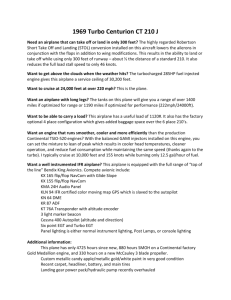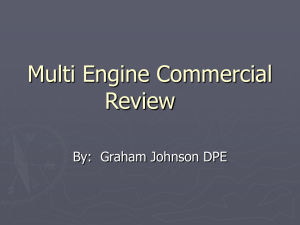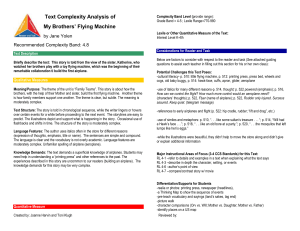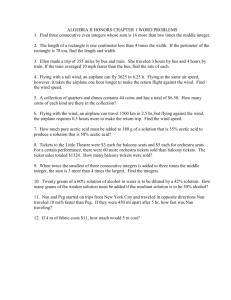Big Al`s First Airplane
advertisement
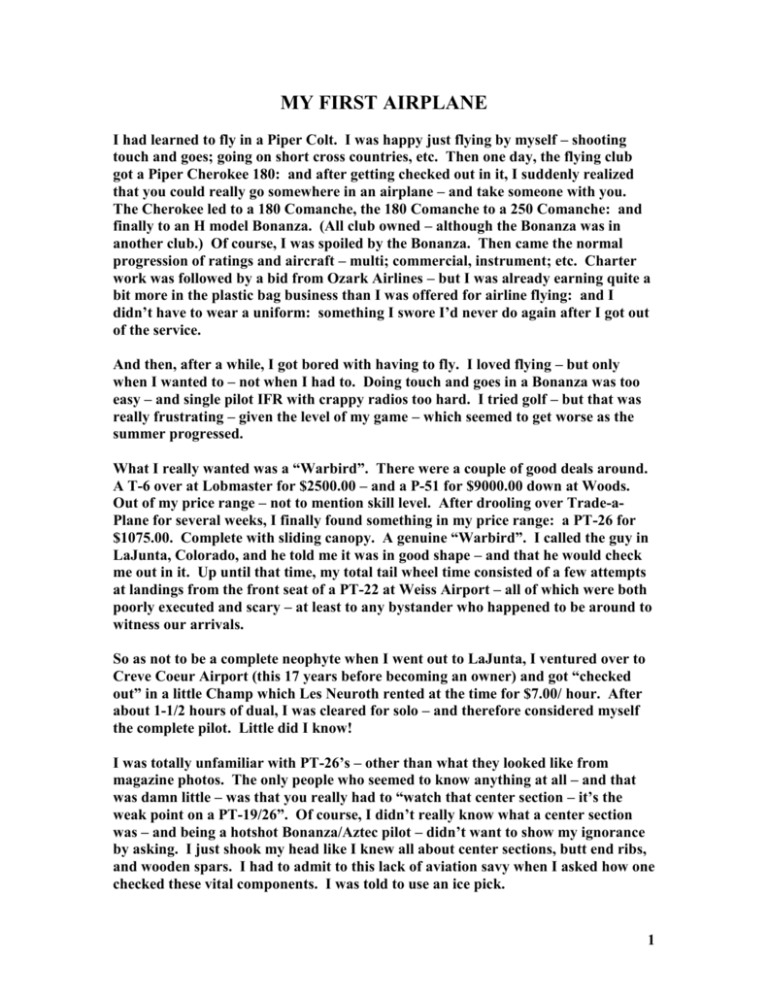
MY FIRST AIRPLANE I had learned to fly in a Piper Colt. I was happy just flying by myself – shooting touch and goes; going on short cross countries, etc. Then one day, the flying club got a Piper Cherokee 180: and after getting checked out in it, I suddenly realized that you could really go somewhere in an airplane – and take someone with you. The Cherokee led to a 180 Comanche, the 180 Comanche to a 250 Comanche: and finally to an H model Bonanza. (All club owned – although the Bonanza was in another club.) Of course, I was spoiled by the Bonanza. Then came the normal progression of ratings and aircraft – multi; commercial, instrument; etc. Charter work was followed by a bid from Ozark Airlines – but I was already earning quite a bit more in the plastic bag business than I was offered for airline flying: and I didn’t have to wear a uniform: something I swore I’d never do again after I got out of the service. And then, after a while, I got bored with having to fly. I loved flying – but only when I wanted to – not when I had to. Doing touch and goes in a Bonanza was too easy – and single pilot IFR with crappy radios too hard. I tried golf – but that was really frustrating – given the level of my game – which seemed to get worse as the summer progressed. What I really wanted was a “Warbird”. There were a couple of good deals around. A T-6 over at Lobmaster for $2500.00 – and a P-51 for $9000.00 down at Woods. Out of my price range – not to mention skill level. After drooling over Trade-aPlane for several weeks, I finally found something in my price range: a PT-26 for $1075.00. Complete with sliding canopy. A genuine “Warbird”. I called the guy in LaJunta, Colorado, and he told me it was in good shape – and that he would check me out in it. Up until that time, my total tail wheel time consisted of a few attempts at landings from the front seat of a PT-22 at Weiss Airport – all of which were both poorly executed and scary – at least to any bystander who happened to be around to witness our arrivals. So as not to be a complete neophyte when I went out to LaJunta, I ventured over to Creve Coeur Airport (this 17 years before becoming an owner) and got “checked out” in a little Champ which Les Neuroth rented at the time for $7.00/ hour. After about 1-1/2 hours of dual, I was cleared for solo – and therefore considered myself the complete pilot. Little did I know! I was totally unfamiliar with PT-26’s – other than what they looked like from magazine photos. The only people who seemed to know anything at all – and that was damn little – was that you really had to “watch that center section – it’s the weak point on a PT-19/26”. Of course, I didn’t really know what a center section was – and being a hotshot Bonanza/Aztec pilot – didn’t want to show my ignorance by asking. I just shook my head like I knew all about center sections, butt end ribs, and wooden spars. I had to admit to this lack of aviation savy when I asked how one checked these vital components. I was told to use an ice pick. 1 So when I boarded the Frontier Air Lines Convair to Denver, I stuck an ice pick into my back pocket – being careful to keep the pointy end from poking through the home made cardboard scabbard into which it was ensconced. A quick change of planes at Denver for the DC-3 ride to Pueblo – never seeming to get more than a couple of thousand feet above the terrain; and well below the towering peaks which lay on either side of our route – and the long journey was over. I called the owner, and he soon arrived in a Comanche, for the trip back to LaJunta. All of this happened long before anyone was worried about what you carried aboard a commercial airliner. Can you imagine bringing an ice pick aboard now? I spotted the PT when we were on downwind. It was painted in a civilian paint scheme of maroon and yellow. I was sold when still at 1000 AGL. I was salivating at the thought that this would soon be my airplane. We landed, and before the prop had stopped turning, I was out of the Comanche and over by the PT. I overlooked the fact that the maroon had faded to an almost purple color – and that the yellow was now a washed out cream. I figured the puddle of oil under the airplane had been from the previous aircraft parked there. Strolling as casually as possible, we went into the typical small airport FBO’s office. The aircraft, was in fact, owned by the FBO. I looked at the logbooks. They could have been for an F-86: but I thumbed through them like I knew what I was looking for/at. He assured me that the plane was in first class condition. I told him I wanted to check the center section, and produced the ice pick. His eyes got real narrow. He said “you’re not sticking that god damned thing in my airplane”. I threw it in the waste basket. He unsquinted. The checkout consisted of a takeoff and climb to about 1000 feet AGL, two 720’s (one of which I fell out of) and two landings. We taxied back to the ramp. Although only at 4238 feet, I was in Heaven! I paid him the $1075.00 in cash. He then said that we could continue a further checkout in the morning – but I had figured to be as far into Kansas as possible that evening; so that I could meet my old army buddy Jimmy Ware in Lawrence the next morning. I had promised my wife that I would be home Sunday afternoon – so I asked him if he thought I could make it with what he had showed me so far. He said “if you’re careful”. I gassed up, filled her with oil, and departed for points East. There’s not much between Lawrence and LaJunta. With only a couple of daylight hours left, I headed toward Dodge City. I don’t know what I expected to see there: perhaps Matt Dillon. But there I sat – chugging along in my very own ‘warbird’ – canopy open, trimmed out, 100 MPH indicated – happy as a clam. I had climbed to about 2500 feet above terrain upon leaving LaJunta – now here I was over Dodge City – and the ground looked like it was a mile below. It was. I also noticed that my right elbow – which had been hanging out into the slipstream, felt all warm; and heavy. I had been wearing an old green cardigan, and when I went to switch hands for the descent, I could feel something warm running down my arm. Like when you 2 cut yourself and not realizing it until you felt the blood running down your arm. Only this wasn’t my blood – it was the engine’s blood: otherwise know as oil. In fact my whole right sleeve was soaked in oil. Well, no time to worry about that now. This was my first solo landing. After spiraling down to pattern altitude (instead of gradually going down hill as I progressed to lower ground levels), the landing was pretty anticlimactic. I taxied over to the pumps, secured the aircraft, and climbed out. That’s when I noticed the whole side of the airplane – both sides – were covered in oil. From nose to tail. And so was my cardigan. The fellow at the pump seemed non plussed about the state of my airplane. (I guess he knew a good oil customer when he saw one). I took on about 25 gallons of fuel, then checked the oil. Then I checked it again – cause nothing was registering on the dipstick. He said something about those Ranger engines sure using up some oil, and suggested I might need to tighten up some of the bolts on the engine. We pushed the plane over to an empty hangar, and shoved it in. He then gave me a couple of wrenches, and helped me de-cowl the sides of the engine for a closer inspection. I don’t think there was one nut or bolt on that engine that didn’t take at least a full turn to tighten. There was oil seeping out of every pore on that motor. I spent a good hour just tightening stuff. Then I wiped off the sides of the plane, using some gasoline and rags. By the time I got done, it was pretty late. I did up the cowling, and made sure all the switches were off in the hangar – closing it up for the night. The fellow at the pumps gave me a ride to one of the local motels. I was too tired to go looking for Matt or Kitty. And I didn’t see one horse on the street, either. I wanted an early start in the morning, so that I could get to Lawrence before noon. That would give me a chance to see Jimmy, and still be home to Arrowhead by dusk. The line person had arranged to pick me up on his way to work, and we got out to the field at first light. Opening up the hangar, the PT glistened in the early light. (I guess it was the residue from the oil.) And she was mine – all mine. We pumped almost 8 gallons of straight 60 weight non-detergent into that tank before it was up to the brim. We pushed her out onto the taxiway, and I donned my helmet and goggles. I pulled the engine through, as I had been told to do by the seller, hopped in, and started her up. Most of the oil was still on my green meanie (sweater), so it was in the baggage compartment, stuffed into a plastic bag from the motel. The engine was started without undue trauma – although I did kill any mosquitoes that happened to be up that early, and taxied toward the runup area. Except that I couldn’t move the stick. It seemed to be stuck! Tug as I might, it would not move. I thought to myself that with that much oil all over this thing, surely it can’t be a frozen bearing. Then I remembered the control lock. I hoped no one had been watching – but it was still pretty early. The runup was uneventful, the altimeter set, and I was off. Back into the wild blue. Whereas the day before had been super calm, today I had a pretty stiff wind directly out of the West. Going up to about 3000 feet above ground level gave me a pretty good shove towards Lawrence. Going up another 1500, gave me even more ground speed. I made Lawrence without an interim stop – all the while keeping a lookout for oil on the side of the plane. I was only 4 gallons down at Lawrence – and it looked like most of the leaks from the engine had stopped. Now most of it was coming out of the stacks 3 – which were pretty sooty. And the breather was weeping a bit. Oh well, what can you expect for $1075.00? My visit with Jimmy, whom I hadn’t seen in several years, was fun. He had married and had a small child. He seemed a much different Jimmy than when were bumming around England and Europe together – but that was 13 years before. At the Lawrence airport, there was a guy with an Aeronca C2. Being the experienced tailwheel guy that I was, I asked him if I could fly it around the pattern. He agreed and I did. It was a faded blue color. You slowed and turned when taxiing by reaching down and grabbing a wheel. Very early airplane – but fun. Once again, I visited the oil store, added fuel, and away I went. The ride home seemed too quick. When I got over Arrowhead, I tried a roll. I never could do a good roll. I flew the airplane almost every day that spring and summer. I got up early and flew it in the morning before I went to work. I flew it again in the evening before I had dinner. I was in it at least four hours every weekend. I was a knight and this was my noble steed. I was once more invigorated about flying. I flew any thing I could get my hands on. I took up a fellow on the field who had a Swift. I told him to be careful - that the PT had a high roll rate. Then I flew his Swift. We had a good laugh over that for years. The airplane was a joy – but the old Ranger was getting a bit tired. I had stopped using straight 60 weight oil, and started putting a can of STP in with every couple of gallons. Then it became every couple of quarts. I became Andy Granitelli’s best friend. It was pumping out so much oil from the breather that I could hire out as a skywriter. Then one day, I took a friend from my Bonanza flying days up for his first PT ride. It was with great trepidation that he consented to go for a ride with me. To him, an old airplane was a straight tailed 172. Into the back seat he climbed, and off we went on Arrowhead’s 2900 foot runway. Except that when we got almost to runway’s end, we were still on the ground. I knew something was wrong, but I was too far down the runway to stop. The old Fairchild wobbled off the ground – but the hill was coming up pretty fast. On top of the hill were two sewage holding ponds. Not a great place for a landing. I ruddered the old girl around to the right, picking up a gap in the trees along side the Missouri River – which flowed just to the West of the airport. I guess we were up to maybe 50 feet AGL by the time I found another break in the trees, and was able to turn right again back towards the airport – onto base. Just one more turn, and I had the field made. Although I had not reduced power, we were still chugging along at about 50 feet above the ground. She just would not gain any altitude. It was a hot summer day, and with our combined 480 pounds and a tired engine, we were just not climbing. I made a wheel landing on the first couple of feet, and cut the power. When I went to raise the flaps, I remembered that I hadn’t tried to lower them – hadn’t need to. 4 To my chagrin, I found them in the partially down position. When we finally came to a stop on the ramp, my Bonanza buddy accused me of intentionally scaring the you know what out of him, by all that low flying. When I explained to him that a hot summer day, a tired engine, and two notches of flaps had conspired to scare us both – that I had not done that low stuff to impress him - he said he was crazy for getting in the Fairchild; and that I was crazy for flying it in the first place. We decided to discuss the whole thing over a couple of G and T’s. The next day, I went back out to the airport. I found that the flap mechanism was so worn that just a little bump would cause the flaps to come out of their detent. As they are split flaps, and have little lift when extended – only drag – I realized how little margin I had had. One thing led to another, and we started finding lots of bad stuff on the airframe. A compression check indicated that either the compression tester was broken, or that the engine was clapped. You could play a tune out of the breather by moving the prop. Not a good sign. There was a mechanic on the field. He looked the plane over Monday morning, and called me at the office. He said it would cost more to fix than it was worth. My valiant stallion had become a gelding overnight. I couldn’t just send him to the glue factory. I decided that I would do the work myself – starting with the engine. So right there on the tiedown, I started pulling the engine apart. For those that don’t know what a Ranger engine looks like, I will explain it in general terms. It is an inline, six cylinder, air cooled engine – positioned on the airframe upside down – so that the crankshaft is at the top of the installation. Although the cylinders are individually placed on the crankcase, you have to pull the cams off to get to the top of the cylinders. It took most of the day to carefully get into the cylinders – and when I got there, I wished I hadn’t. There was a hole in the first piston – right in the middle of it – that you could stick your thumb in. In the second piston, the hole was only slightly smaller. Number 3 was much better – I could only get my little finger in that one. Some of the pistons had some of the rings left on them. Some of them even looked like they were making contact with the cylinder walls – but not by much. I have never seen any engine – automobile or aircraft engine – that was in such a worn out state and still ran. I think the only thing that was keeping this engine together was STP – which by this time, accounted for 95% of what was in the oil tank. (I remember that on chilly mornings, you could chin yourself on the prop.) I was leaning against the vertical, considering the situation, when it moved. A lot. I guess the termites had decided to stop holding hands. The whole situation was just too much for me to deal with, so I packed up my tools, put the parts into the airplane, and repaired to my favorite watering hole up on the hill. Perhaps the bartender could solve my problems. The next day at the office I receive a call from the mechanic on the field. He wanted to know if I wanted to sell the plane. Boy – did I ever! So for the sum of $550.00, I sold the plane to Jack Chastain – who I had seen around the airport – but didn’t 5 really know. It went to a good home: Jack and his two sons Phil and Terry, rebuilt that airplane into the best looking, Oshkosh trophy winning PT-26 you ever laid eyes on. Although I really had never met either of the two boys during the rebuild process, (nor was I even aware it was going on) – the three of us became fast friends a few years later, when they both became hangar owners at Creve Coeur Airport – along with the PT. I also got to know Mrs. Chastain very well – and May Belle is now as much a part of Creve Coeur Airport – I’d call her the Mother Superior – as anyone there – pilot or not. Unfortunately, Jack succumbed to cancer before I really got to know him well. He was a wonderful and talented man – and courageous, as well. I say that because he “checked me out” in my “Tora” Kate, a few years later. But that’s another story. 6
